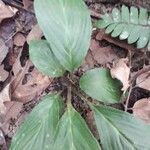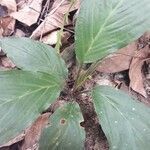Rhizome cylindric, growing vertically, up to 12 cm long by up to 3 cm ø. Leaves 2-13, rosulate, very variable, usually oblong(-ovate) or lanceolate, more rarely elliptic, oblong-obovate or linear-lanceolate, greyish green, 7.5-65 by 3-24 cm, base attenuate, rarely cuneate or rounded, apex acuminate; nerves pinnate; petiole 4.5-41 cm by 2-6 mm, sheath 2.5-17 by 0.5-1.5 cm. Inflorescences 1-4(-5), up to 30-flowered; scape 9-65(-100) cm by 2-7 mm, dark violet, blackish purple, red, or rarely brown. Involucral bracts 4, very variable, 2 outer bracts opposite, 2 inner ones inplanted together more or less in the axil of one of the outer bracts; outer ones sessile, elliptic, oblong, (narrowly) triangular, or (ovate) lanceolate, 1.5-14 by 0.5-7 cm, green to purple, veined black, apex acute, acuminate, rarely cuspidate; inner bracts thinner than the outer ones, sessile or with attenuate to cuneate base, (ob)ovate, oblong-(ob)ovate, (ob)-lanceolate, or spatulate, rarely orbicular, 2.5-22 by 1-11 cm, white, shaded purple, veined black, apex acuminate or cuspidate. Filiform bracts 5-27, up to 25 cm by 0.2-1 mm, white or bright yellow green, on base darker. Flowers 1.4-2.7 by 0.6-3.2 cm; buds pale greenish, flowers green, greenish-violet, brownish-purple, or blackish-violet, the colour becomes steadily darker; pedicel 0.5-4 cm by 1-2 mm, dark red or blackish-purple; perianth tube 3-8 by 9-15 mm. Perianth lobes mostly reflexed during anthesis and caducous; 3 outer ones elliptic, triangular or oblong, 6-15 (-20) by 4-9 mm, inner ones broadly obovate or broadly ovate, 5-15 by 5-16 mm; at apex emarginate, retuse, rounded, acute, acuminate, or mucronate. Stamens: adnate portion of the filaments 2-3 by 0.5-1 mm, free apical portion up to 3 by 1.5 mm, thecae up to 2 mm long. Ovary 3-15 by 2-7 mm, yellowish green with sepia-purple ribs; disk absent; style 1-3 by 1-3 mm; stigma lobes 1 by 1.5 mm. Fruit triangular to circular in cross-section, 2.5-5 by 1-2.5 cm, green to black, tinged with purple, pericarp up to 2 mm thick. Seeds ovoid convex-concave, 3.5-6 by 1-3.5 by 1-2 mm, glabrous to strongly papillose, 6-16-ribbed.
More
Rhizomes subcylindric, thick. Leaf blade oblong-lanceolate to oblong-elliptic, 50--55 × 18.5--21 cm, base cuneate, apex acuminate, sometimes caudate. Scape ca. 55 cm; involucral bracts 4, outer 2 sessile, narrowly deltoid-ovate, inner 2 long petiolate, spatulate, thin. Perianth purplish black; tube 1--2 cm; lobes 6, in 2 whorls, outer ones narrowly oblong, inner ones broadly obovate. Filaments spatulate at apex. Style extremely short; stigma deeply 3-lobed. Berry narrowly ellipsoid, 4--5 × ca. 2 cm, fleshy, 6-ridged, with persistent perianth lobes. Seeds irregulaly ellipsoid-ovoid. Fl. Jul--Aug.
A herb which has tubers and becomes dormant for part of the year. It grows 75 cm high. The leaves form at the base and are sword shaped or broadly oval. They are 50 cm long. They are glossy dark green. The leaf stalks are purple. The flowers are purplish. They have short stalks. There are 2 broad, spreading bracts. These are white to purple. There are 2 narrower bracts below. There are long threadlike bracteoles. These are 20-25 cm long.


